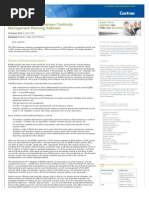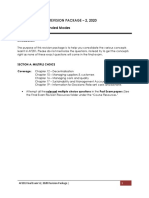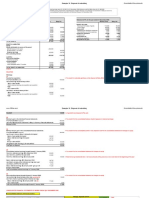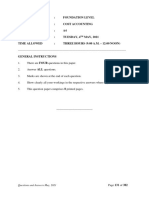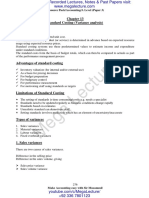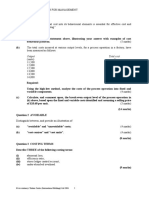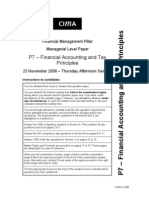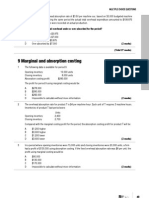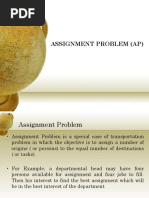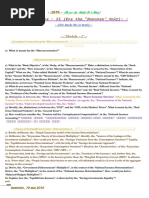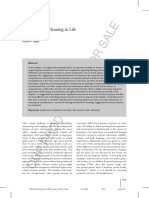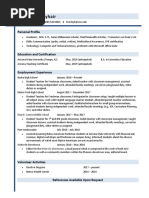The Assignment Problem: Basic Concepts
The Assignment Problem: Basic Concepts
Uploaded by
shouvik palCopyright:
Available Formats
The Assignment Problem: Basic Concepts
The Assignment Problem: Basic Concepts
Uploaded by
shouvik palOriginal Title
Copyright
Available Formats
Share this document
Did you find this document useful?
Is this content inappropriate?
Copyright:
Available Formats
The Assignment Problem: Basic Concepts
The Assignment Problem: Basic Concepts
Uploaded by
shouvik palCopyright:
Available Formats
12 The Assignment Problem
Basic Concepts
Assignment The Assignment Problem is another special case of LPP. It
Algorithm occurs when m jobs are to be assigned to n facilities on a
one-to-one basis with a view to optimising the resource
required.
Steps for Solving Assignment problem can be solved by applying the following
the Assignment steps:
Problem Step-1: Subtract the minimum element of each row from all
the elements in that row. From each column of the matrix so
obtained, subtract its minimum element. The resulting matrix
is the starting matrix for the following procedure.
Step-2: Draw the minimum number of horizontal and vertical
lines that cover all the zeros. If this number of lines is n,
order of the matrix, optimal assignment can be made by
skipping steps 3 and 4 and proceeding with step 5. If,
however, this number is less than n, go to the next step.
Step-3: Here, we try to increase the number of zeros in the
matrix. We select the smallest element out of these which do
not lie on any line. Subtract this element from all such
(uncovered) elements and add it to the elements which are
placed at the intersections of the horizontal and vertical lines.
Do not alter the elements through which only one line passes.
Step-4: Repeat steps 1, 2 and 3 until we get the minimum
number of lines equal to n.
Step-5(A): Starting with first row, examine all rows of matrix
in step 2 or 4 in turn until a row containing exactly one zero
is found. Surround this zero by ( ), indication of an
assignment there. Draw a vertical line through the column
containing this zero. This eliminates any confusion of making
any further assignments in that column. Process all the rows
in this way.
© The Institute of Chartered Accountants of India
The Assignment Problem 12.2
Step-5(B): Apply the same treatment to columns also. Starting
with the first column, examine all columns until a column
containing exactly one zero is found. Mark ( ) around this
zero and draw a horizontal line through the row containing
this marked zero. Repeat steps 5A and B, until one of the
following situations arises:
– No unmarked ( ) or uncovered (by a line) zero is left,
– There may be more than one unmarked zero in one
column or row. In this case, put around one of the
unmarked zero arbitrarily and pass 2 lines in the cells of
the remaining zeros in its row and column. Repeat the
process until no unmarked zero is left in the matrix.
Unbalanced Like the unbalanced transportation problems there could
Assignment arise unbalanced assignment problems too. They are to be
Problems handled exactly in the same manner i.e., by introducing
dummy jobs or dummy men, etc.
© The Institute of Chartered Accountants of India
12.3 Advanced Management Accounting
Steps to Solve Assignment Problem
Question-1
Prescribe the steps to be followed to solve an assignment problem.
Answer
The assignment problem can be solved by applying the following steps-
Step-1:
Subtract the minimum element after row operation of each row from all the elements in that
row. From each column of the matrix so obtained, subtract its minimum element. The resulting
matrix is the starting matrix for the following procedure.
Step-2:
Draw the minimum number of horizontal and vertical lines that cover all the zeros. If this
number of lines is n, order of the matrix, optimal assignment can be made by skipping steps 3
and 4 and proceeding with step 5. If, however, this number is less than n, go to the next step
Step-3:
Here, we try to increase the number of zeros in the matrix. We select the smallest element out
of these which do not lie on any line. Subtract this element from all such (uncovered) elements
and add it to the elements which are placed at the intersections of the horizontal and vertical
lines. Do not alter the elements through which only one line passes.
Step-4:
Repeat steps 1, 2 and 3 until we get the minimum number of lines equal to n.
Step-5(A):
Starting with first row, examine all rows of matrix in step 2 or 4 in turn until a row containing
exactly one zero is found. Surround this zero by ( ), indication of an assignment there. Draw
a vertical line through the column containing this zero. This eliminates any confusion of
making any further assignments in that column. Process all the rows in this way.
Step5 (B): Apply the same treatment to columns also. Starting with the first column, examine
all columns until a column containing exactly one zero is found. Mark ( ) around this zero and
draw a horizontal line through the row containing this marked zero. Repeat steps 5A and B,
until one of the following situations arises:
© The Institute of Chartered Accountants of India
The Assignment Problem 12.4
– No unmarked ( ) or uncovered (by a line) zero is left,
– There may be more than one unmarked zero in one column or row. In this case, put
around one of the unmarked zero arbitrarily and pass 2 lines in the cells of the remaining
zeros in its row and column. Repeat the process until no unmarked zero is left in the
matrix.
© The Institute of Chartered Accountants of India
12.5 Advanced Management Accounting
Minimization Problem
Problem-1
An Electronic Data Processing (EDP) centre has three expert Software professionals. The
Centre wants three application software programs to be developed. The head of EDP Centre
estimates the computer time in minutes required by the experts for development of Application
Software Programs as follows-
Computer Time (in minutes)
Software Programs Required by Software Professionals
A B C
1 100 85 70
2 50 70 110
3 110 120 130
Required
Assign the software professionals to the application software programs to ensure minimum
usage of computer time.
Solution
The given problem is a balanced minimization assignment problem.
The minimum time elements in row 1, 2 and 3 are 70, 50 and 110 respectively. Subtract these
elements from all elements in their respective row. The reduced matrix is shown below-
A B C
1 30 15 0
2 0 20 60
3 0 10 20
The minimum time elements in columns A, B and C are 0, 10, and 0 respectively. Subtract
these elements from all the elements in their respective columns to get the reduced time
matrix as shown below-
© The Institute of Chartered Accountants of India
The Assignment Problem 12.6
A B C
1 30 5 0
2 0 10 60
3 0 0 20
The minimum number of horizontal and vertical lines to cover all zeros is 3, which is equal to
the order of the matrix.
The Pattern of assignments among software professionals and programs with their respective
time (in minutes) is given below-
Program Software Professionals Time (in Minutes)
1 C 70
2 A 50
3 B 120
Total 240
Problem-2
A project consists of four (4) major jobs, for which four (4) contractors have submitted tenders.
The tender amounts, in thousands of rupees, are given below-
Contractors Job A Job B Job C Job D
1 120 100 80 90
2 80 90 110 70
3 110 140 120 100
4 90 90 80 90
Required
Find the assignment, which minimizes the total cost of the project. Each contractor has to be
assigned one job.
Solution
The given problem is a balanced minimization problem. Subtracting the minimum element of
each row from all its elements in turn, the given problem reduces to-
© The Institute of Chartered Accountants of India
12.7 Advanced Management Accounting
Contractors Job A Job B Job C Job D
1 40 20 0 10
2 10 20 40 0
3 10 40 20 0
4 10 10 0 10
Now subtract the minimum element of each column from all its elements in turn. Draw the
minimum number of lines horizontal or vertical so as to cover all zeros.
Contractors Job A Job B Job C Job D
1 30 10 0 10
2 0 10 40 0
3 0 30 20 0
4 0 0 0 10
Since the minimum number of lines to cover all zeros is equal to 4(order of the matrix), this
matrix will give optimal solution. The optimal assignment is made in the matrix below-
Contractors Job A Job B Job C Job D
1 30 10 0 10
2 0 10 40 0
3 0 30 20 0
4 0 0 0 10
The optimal assignment is-
Contractor Job Cost (‘000 `)
1 C 80
2 A 80
3 D 100
4 B 90
Hence, total minimum cost of the project will be `3,50,000.
© The Institute of Chartered Accountants of India
The Assignment Problem 12.8
Problem-3
A Marketing Manager has 4 subordinates and 4 tasks. The subordinates differ in efficiency.
The tasks also differ in their intrinsic difficulty. His estimates of the time each subordinate
would take to perform each task is given in the matrix below.
I II III IV
1 16 52 34 22
2 26 56 8 52
3 76 38 36 30
4 38 52 48 20
Required
How should the task be allocated one to one man so that the total man-hours are minimised?
Solution
Step 1
Subtract the smallest element of each row from every element of the corresponding row.
I II III IV
1 0 36 18 6
2 18 48 0 44
3 46 8 6 0
4 18 32 28 0
Step 2
Subtract the smallest element of each column from every element in that column.
I II III IV
1 0 28 18 6
2 18 40 0 44
3 46 0 6 0
4 18 24 28 0
Step 3
Drew minimum number of horizontal and vertical lines to cover all the zeros
© The Institute of Chartered Accountants of India
12.9 Advanced Management Accounting
I II III IV
1 0 28 18 6
2 18 40 0 44
3 46 0 6 0
4 18 24 28 0
Since, No. of lines are equal to order of matrix, hence, solution is optimal.
1 I 16 hrs.
2 III 8 hrs.
3 II 38 hrs.
4 IV 20 hrs.
Total 82 hrs.
Minimum time taken is 82 hrs.
Problem-4
Five swimmers are eligible to compete in a relay team which is to consist of four swimmers
swimming four different swimming styles ; back stroke breast stroke, free style and butterfly.
The time taken for the five swimmers – Anand, Bhaskar, Chandru, Dorai and Easwar- to cover
a distance of 100 meters in various swimming styles are given below in minutes : seconds.
Anand swims the back stroke in 1:09, the breast stroke in 1:15 and has never competed in the
free style or butterfly. Bhaskar is a free style specialist averaging 1:01 for the 100 metres but
can also swim the breast stroke in 1:16 and butterfly in 1:20. Chandru swims all styles – back
storke 1:10, butterfly 1:12, free style 1:05 and breast stroke 1:20. Dorai swims only the
butterfly 1:11 while Easwar swims the back stroke 1:20, the breast stroke 1:16, the free style
1:06 and the butterfly 1:10.
Required
Which swimmers should be assigned to which swimming style? Who will be in the relay?
Solution
Let us first create the assignment matrix with time expressed in seconds. Also it is an
unbalanced assignment problem hence a dummy style is added to balance it.
© The Institute of Chartered Accountants of India
The Assignment Problem 12.10
Back Stroke Breast Stroke Free Style Butterfly Dummy
Anand 69 75 - - 0
Bhaskar - 76 61 80 0
Chandru 70 80 65 72 0
Dorai - - - 71 0
Easwar 80 76 66 70 0
Step 1
As there is a zero in each row, we go straight to the column reduction-
Back Stroke Breast Stroke Free Style Butterfly Dummy
Anand 0 0 - - 0
Bhaskar - 1 0 10 0
Chandru 1 5 4 2 0
Dorai - - - 1 0
Easwar 11 1 5 0 0
Step 2
The minimum number of lines to cover all zeros is 4, which is less than 5, the order of the
square matrix. Hence, the above matrix will not provide the optimal solution. Thus we try to
increase the number of zeros. Select the minimum uncovered element by these lines (which is
1). Subtract it from all the uncovered elements and add it to the elements lying on the
intersection of lines, as drawn above. The revised matrix will be-
Back Stroke Breast Stroke Free Style Butterfly Dummy
Anand 0 0 - - 1
Bhaskar - 1 0 11 1
Chandru 0 4 3 2 0
Dorai - - - 1 0
Easwar 10 0 4 0 0
As the minimum number of lines to cover all zeros is 5, which is equal to the order of the
square matrix, the above matrix will provide the optimal solution. The assignment is made
below-
© The Institute of Chartered Accountants of India
12.11 Advanced Management Accounting
Swimmer Swimming Style Time (Seconds)
Anand Breast Stroke 75
Bhaskar Free Style 61
Chandru Back Stroke 70
Dorai Dummy (not participate) -
Easwar Butterfly 70
Total Minimum Time in the relay 276
Dorai will be out of the relay.
Problem-5
ABC company is engaged in manufacturing 5 brands of packet snacks. It is having five
manufacturing setups, each capable of manufacturing any of its brands, one at a time. The
cost to make a brand on these setups vary according to following table-
S1 S2 S3 S4 S5
B1 4 6 7 5 11
B2 7 3 6 9 5
B3 8 5 4 6 9
B4 9 12 7 11 10
B5 7 5 9 8 11
Required
Assuming five setups are S1, S2, S3, S4, and S5 and five brands are B1, B2, B3, B4, and B5, Find
the optimum assignment of the products on these setups resulting in the minimum cost.
Solution
This is an assignment problem whose objective is to assign on manufacturing set up to one
brand so that the total cost of production is minimum. To determine the appropriate
assignment, let us apply the assignment algorithm.
Subtract the minimum element of each row from all elements of that row to get the following
matrix-
© The Institute of Chartered Accountants of India
The Assignment Problem 12.12
Manufacturing Setups
Brands
S1 S2 S3 S4 S5
B1 0 2 3 1 7
B2 4 0 3 6 2
B3 4 1 0 2 5
B4 2 5 0 4 3
B5 2 0 4 3 6
Now subtract the minimum elements of each column from all elements of that column-
Manufacturing Setups
Brands
S1 S2 S3 S4 S5
B1 0 2 3 0 5
B2 4 0 3 5 0
B3 4 1 0 1 3
B4 2 5 0 3 1
B5 2 0 4 2 4
The minimum number of lines drawn to cover all zeros is equal to 4 which is one less than the
order of the matrix (= 5), the above table will not yield the optimal assignment. For obtaining
the optimal assignment, we increase the number of zeroes by subtracting the minimum
uncovered element from all uncovered elements and adding it to elements lying at the
intersection of two lines, we get the following matrix-
Manufacturing Setups
Brands
S1 S2 S3 S4 S5
B1 0 3 4 0 5
B2 4 1 4 5 0
B3 3 1 0 0 2
B4 1 5 0 2 0
B5 1 0 4 1 3
Since the minimum number of lines required to cover all zeros is five, the above table will give
the optimal solution. The required assignment is made as below-
© The Institute of Chartered Accountants of India
12.13 Advanced Management Accounting
Brand Setup Cost
B1 S1 4
B2 S5 5
B3 S4 6
B4 S3 7
B5 S2 5
Total 27
Problem-6
A Production supervisor is considering, how he should assign five jobs that are to be
performed, to five mechanists working under him. He wants to assign the jobs to the
mechanists in such a manner that the aggregate cost to perform the jobs is the least. He has
following information about the wages paid to the mechanists for performing these jobs-
Mechanist Job1 Job 2 Job 3 Job 4 Job 5
A 10 3 3 2 8
B 9 7 8 2 7
C 7 5 6 2 4
D 3 5 8 2 4
E 9 10 9 6 10
Required
Assign the jobs to the mechanists so that the aggregate cost is the least.
Solution
The given problem is a balanced minimization problem.
Subtracting minimum element of each row from all the elements of that row, the given problem
reduces to-
Mechanist Job1 Job 2 Job 3 Job 4 Job 5
A 8 1 1 0 6
B 7 5 6 0 5
C 5 3 4 0 2
D 1 3 6 0 2
E 3 4 3 0 4
© The Institute of Chartered Accountants of India
The Assignment Problem 12.14
Subtract the minimum element of each column from all the elements of that column. Draw the
minimum number of lines horizontal or vertical so as to cover all zeros.
Mechanist Job1 Job 2 Job 3 Job 4 Job 5
A 7 0 0 0 4
B 6 4 5 0 3
C 4 2 3 0 0
D 0 2 5 0 0
E 2 3 2 0 2
Since the minimum number of lines covering all zeros is equal to 4 which is less than the
number of columns / rows (=5), the above table will not provide optimal solution. Subtract the
minimum uncovered element (=2) from all uncovered elements and add to the elements lying
on the intersection of two lines, we get the following matrix-
Mechanist Job1 Job 2 Job 3 Job 4 Job 5
A 7 0 0 2 6
B 4 2 3 0 3
C 2 0 1 0 0
D 0 2 5 2 2
E 0 1 0 0 2
Since the minimum number of horizontal and vertical lines to cover all zeros is equal to five
which is equal to the order of the matrix, the above table will give the optimal solution. The
optimal assignment is made below-
Mechanist Job1 Job 2 Job 3 Job 4 Job 5
A 7 0 0 2 6
B 4 2 3 0 3
C 2 0 1 0 0
D 0 2 5 2 2
E 0 1 0 0 2
© The Institute of Chartered Accountants of India
12.15 Advanced Management Accounting
The optimal assignment is given below-
Mechanist Job Wages
A 2 3
B 4 2
C 5 4
D 1 3
E 3 9
Total 21
The total least cost associated with the optimal mechanist-job assignment equals to 21.
Problem-7
A factory is going to modify of a plant layout to install four new machines M1, M2, M3 and M4.
There are 5 vacant places J, K, L, M and N available. Because of limited space machine M2
cannot be placed at L and M3 cannot be placed at J. The cost of locating machine to place in
Rupees is shown below:
(` )
J K L M N
M1 18 22 30 20 22
M2 24 18 -- 20 18
M3 -- 22 28 22 14
M4 28 16 24 14 16
Required
Determine the optimal assignment schedule in such a manner that the total costs are kept at a
minimum.
Solution
Dummy machine (M5) is inserted to make it a balanced cost matrix and assume its installation
cost to be zero. Cost of install at cell M3 (J) and M2 (L) is very high marked as M.
J K L M N
M1 18 22 30 20 22
M2 24 18 M 20 18
© The Institute of Chartered Accountants of India
The Assignment Problem 12.16
M3 M 22 28 22 14
M4 28 16 24 14 16
M5 (Dummy) 0 0 0 0 0
Step 1
Subtract the minimum element of each row from each element of that row-
J K L M N
M1 0 4 12 2 4
M2 6 0 M 2 0
M3 M 8 14 8 0
M4 14 2 10 0 2
M5 (Dummy) 0 0 0 0 0
Step 2
Subtract the minimum element of each column from each element of that column-
J K L M N
M1 0 4 12 2 4
M2 6 0 M 2 0
M3 M 8 14 8 0
M4 14 2 10 0 2
M5 (Dummy) 0 0 0 0 0
Step 3
Draw lines to connect the zeros as under-
J K L M N
M1 0 4 12 2 4
M2 6 0 M 2 0
M3 M 8 14 8 0
M4 14 2 10 0 2
M5 (Dummy) 0 0 0 0 0
© The Institute of Chartered Accountants of India
12.17 Advanced Management Accounting
There are five lines which are equal to the order of the matrix. Hence the solution is optimal.
We may proceed to make the assignment as under-
J K L M N
M1 0 4 12 2 4
M2 6 0 M 2 0
M3 M 8 14 8 0
M4 14 2 10 0 2
M5 (Dummy) 0 0 0 0 0
The following is the assignment which keeps the total cost at minimum-
Machines Location Costs (`)
M1 J 18
M2 K 18
M3 N 14
M4 M 14
M5 (Dummy) L 0
Total 64
Problem-8
A private firm employs typists on hourly piece rate basis for their daily work. Five typists are
working in that firm and their charges and speeds are different. On the basis of some earlier
understanding, only one job is given to one typist and the typist is paid for full hours even
when he or she works for a fraction of an hour.
Typist Rate per hour (`) No. of pages typed per hour
A 5 12
B 6 14
C 3 8
D 4 10
E 4 11
© The Institute of Chartered Accountants of India
The Assignment Problem 12.18
Job No. of pages
P 199
Q 175
R 145
S 298
T 178
Required
Find the least cost allocation for the above data.
Solution
The following matrix gives the cost incurred if the typist (i = A, B, C, D, E) executes the job (j =
P, Q, R, S, T).
Typist Job P Job Q Job R Job S Job T
A 85 75 65 125 75
B 90 78 66 132 78
C 75 66 57 114 69
D 80 72 60 120 72
E 76 64 56 112 68
Subtracting the minimum element of each row from all its elements in turn, the above matrix
reduces to-
Typist Job P Job Q Job R Job S Job T
A 20 10 0 60 10
B 24 12 0 66 12
C 18 9 0 57 12
D 20 12 0 60 12
E 20 8 0 56 12
Now subtract the minimum element of each column from all its elements in turn, and draw
minimum number of lines horizontal or vertical so as to cover all zeros. All zeros can be
covered by four lines as given below-
© The Institute of Chartered Accountants of India
12.19 Advanced Management Accounting
Typist Job P Job Q Job R Job S Job T
A 2 2 0 4 0
B 6 4 0 10 2
C 0 1 0 1 2
D 2 4 0 4 2
E 2 0 0 0 2
Since there are only 4 lines (<5) to cover all zeros, optimal assignment cannot be made. The
minimum uncovered element is 1.
We subtract the value 1 from all uncovered elements, add this value to all intersections of two
lines values and leave the other elements undisturbed. The revised matrix so obtained is
given below-
Typist Job P Job Q Job R Job S Job T
A 3 2 1 4 0
B 6 3 0 9 1
C 0 0 0 0 1
D 2 3 0 3 1
E 3 0 1 0 2
Since the minimum no. of lines required to cover all the zeros is only 4 (< 5), optimal
assignment cannot be made at this stage also.
The minimum uncovered element is 2. Repeating the usual process again, we get the
following matrix-
Typist Job P Job Q Job R Job S Job T
A 1 0 1 2 0
B 4 1 0 7 1
C 0 0 2 0 3
D 0 1 0 1 1
E 3 0 3 0 4
Since the minimum number of lines to cover all zeros is equal to 5, this matrix will give optimal
solution. The optimal assignment is made in the matrix below-
© The Institute of Chartered Accountants of India
The Assignment Problem 12.20
Typist Job P Job Q Job R Job S Job T
A 1 0 1 2 0
B 4 1 0 7 1
C 0 0 2 0 3
D 0 1 0 1 1
E 3 0 3 0 4
Typist Job Cost (`)
A T 75
B R 66
C Q 66
D P 80
E S 112
Total 399
Note
In this case the above solution is not unique. Alternate solution also exists.
Problem-9
A car hiring company has one car at each of the five depots A, B C, D and E. A customer in
each of the five towns V, W, X, Y and Z requires a car. The distance in kms, between depots
(origin) and the town (destination) are given in the following table-
Depots
Town
A B C D E
V 3 5 10 15 8
W 4 7 15 18 8
X 8 12 20 20 12
Y 5 5 8 10 6
Z 10 10 15 25 10
Required
Find out as to which car should be assigned to which customer so that the total distance
travelled is a minimum. How much is the total travelled distance?
© The Institute of Chartered Accountants of India
12.21 Advanced Management Accounting
Solution
The given problem is a balance minimization assignment problem. Let us apply the
assignment algorithm to find the optimal assignment. Subtracting the smallest element of
each row from all the elements of that row, we get the following table-
Depots
Town
A B C D E
V 0 2 7 12 5
W 0 3 11 14 4
X 0 4 12 12 4
Y 0 0 3 5 1
Z 0 0 5 15 0
Subtracting the smallest element of each column from all the elements of that column, wet get
the following-
Depots
Town
A B C D E
V 0 2 4 7 5
W 0 3 8 9 4
X 0 4 9 7 4
Y 0 0 0 0 1
Z 0 0 2 10 0
Draw the minimum number of lines to cover all zeros. Since the number of lines (=3) is not
equal to the order of the matrix (which is 5), the above matrix will not give the optimal solution.
Subtract the minimum uncovered element (=2) from all uncovered elements and add it to the
elements lying on the intersection of two lines, we get the following matrix-
Depots
Town
A B C D E
V 0 0 2 5 3
W 0 1 6 7 2
X 0 2 7 5 2
Y 2 0 0 0 1
Z 2 0 2 10 0
© The Institute of Chartered Accountants of India
The Assignment Problem 12.22
Against, the minimum number of lines of cover all zeros is 4, which is less than the order of
the matrix. Subtract the uncovered element (=2) from all the uncovered element and add it to
the elements lying on the intersection of two lines, we get-
Depots
Town
A B C D E
V 0 0 0 3 1
W 0 1 4 5 0
X 0 2 5 3 0
Y 4 2 0 0 1
Z 4 2 2 10 0
Since the minimum number of lines to cover all zeros is 4 which is less than the order of the
matrix, hence, the above matrix will not give the optimal solution. Subtracting the uncovered
element (=1) from all the uncovered elements and adding it to the elements lying on the
intersection of two lines, we get-
Depots
Town
A B C D E
V 1 0 0 3 2
W 0 0 3 4 0
X 0 1 4 2 0
Y 5 2 0 0 2
Z 4 1 1 9 0
Since the minimum number of lines of cover all zeros is 5 which is equal to the order of the
matrix, the above table will give the optimal assignment. The optimal assignment is made
below-
This optimal assignment is-
Customer at Town Car at Depot Distance (Km.)
V C 10
W B 7
X A 8
Y D 10
Z E 10
Total 45
Hence the minimum total travelled distance equals to 45 kms.
© The Institute of Chartered Accountants of India
12.23 Advanced Management Accounting
Maximization Problem
Problem-10
A company has four zones open and four marketing managers available for assignment. The
zones are not equal in sales potentials. It is estimated that a typical marketing manager
operating in each zone would bring in the following Annual sales:
Zones (`)
East………………………………………………. 2,40,000
West……………………………………………… 1,92,000
North……………………………………………... 1,44,000
South…………………………………………….. 1,20,000
The four marketing manages are also different in ability. It is estimated that working under the
same conditions, their yearly sales would be proportionately as under:
Manager M………………………………………. 8
Manager N………………………………………. 7
Manager O………………………………………. 5
Manager P………………………………………. 4
Required
If the criterion is maximum expected total sales, find the optimum assignment and the
maximum sales.
Solution
Sum of the proportion is 24 (8 + 7 + 5 + 4). Assuming `1,000 as one unit, the effective matrix
is as follows-
Effective Matrix
Manager Zones
East West North South
M 80 64 48 40
[(8/24) 240] [(8/24) 192] [(8/24) 144] [(8/24) 120]
N 70 56 42 35
[(7/24) 240] [(7/24) 192] [(7/24) 144] [(7/24) 120]
O 50 40 30 25
[(5/24) 240] [(5/24) 192] [(5/24) 144] [(5/24) 120]
P 40 32 24 20
[(4/24) 240] [(4/24) 192] [(4/24) 144] [(4/24) 120]
© The Institute of Chartered Accountants of India
The Assignment Problem 12.24
Convert the maximization problem to minimization problem. The resultant loss matrix is as
follows-
Loss Matrix
Manager East West North South
M 0 16 32 40
N 10 24 38 45
O 30 40 50 55
P 40 48 56 60
Row Operation
Manager East West North South
M 0 16 32 40
N 0 14 28 35
O 0 10 20 25
P 0 8 16 20
Column Operation
Manager East West North South
M 0 8 16 20
N 0 6 12 15
O 0 2 4 5
P 0 0 0 0
No. of lines are 2 which is less than the order of matrix, hence, this is not an optimal solution.
Lowest uncovered element 2 shall be deducted from all uncovered cells value and added to
the value at intersections.
Manager East West North South
M 0 6 14 18
N 0 4 10 13
O 0 0 2 3
P 2 0 0 0
© The Institute of Chartered Accountants of India
12.25 Advanced Management Accounting
Again no. of lines covering zeros are not equal to the order of matrix, therefore, lowest
uncovered element 2 shall be deducted from all uncovered cells value and added with value at
intersections.
Manager East West North South
M 0 6 12 16
N 0 4 8 11
O 0 0 0 1
P 4 2 0 0
Once again no. of lines covering zeros are not equal to the order of matrix, therefore, lowest
uncovered element 4 shall be deducted from all uncovered cells value and added with value at
intersections.
Manager East West North South
M 0 2 8 12
N 0 0 4 7
O 4 0 0 1
P 8 2 0 0
Now the number of lines covering zeros are equal to the order of matrix, hence, this is the
optimal solution.
Assignment Sales (`)
M - East 80,000
N - West 56,000
O - North 30,000
P - South 20,000
Total 1,86,000
Problem-11
Five lathes are to be allotted to five operators (one for each). The following table gives weekly
output figures (in pieces)-
© The Institute of Chartered Accountants of India
The Assignment Problem 12.26
Weekly Output in Lathe
Operator
L1 L2 L3 L4 L5
P 20 22 27 32 36
Q 19 23 29 34 40
R 23 28 35 39 34
S 21 24 31 37 42
T 24 28 31 36 41
Profit per piece is ` 25.
Required
Find the maximum profit per week.
Solution
The given assignment problem is a maximization problem. Let us convert it into an opportunity
loss matrix by subtracting all the elements of the given table from the highest element of the
table that is 42.
Weekly Output in Lathe
Operator
L1 L2 L3 L4 L5
P 22 20 15 10 6
Q 23 19 13 8 2
R 19 14 7 3 8
S 21 18 11 5 0
T 18 14 11 6 1
The assignment procedure is now applies to above problem. Subtract the minimum element of
each row from all the elements of that row, and repeat this step with all the rows of the table.
Weekly output in lathe
Operator
L1 L2 L3 L4 L5
P 16 14 9 4 0
Q 21 17 11 6 0
R 16 11 4 0 5
S 21 18 11 5 0
T 17 13 10 5 0
© The Institute of Chartered Accountants of India
12.27 Advanced Management Accounting
Repeat the above step with the columns of the table also. Subtract the minimum element of
each column from all the elements of that column.
Weekly Output in Lathe
Operator
L1 L2 L3 L4 L5
P 0 3 5 4 0
Q 5 6 7 6 0
R 0 0 0 0 5
S 5 7 7 5 0
T 1 2 6 5 0
Since the minimum number of lines to cover all zeros is 3 which is less than 5 (order of the
square matrix), the above matrix will not give the optimal solution. Hence we try to increase
the number of zeros. Subtract the least uncovered element which is 2 from all uncovered
elements and add it to all the elements lying on the intersection of two lines. We get the
following matrix-
Weekly Output in Lathe
Operator
L1 L2 L3 L4 L5
P 0 1 3 2 0
Q 5 4 5 4 0
R 2 0 0 0 7
S 5 5 5 3 0
T 1 0 4 3 0
Again, the minimum number of lines drawn to cover all zeros is 4. Repeating the above steps
once again, we get the following table-
Weekly Output in Lathe
Operator
L1 L2 L3 L4 L5
P 0 2 3 2 1
Q 4 4 4 3 0
R 2 1 0 0 8
S 4 5 4 2 0
T 0 0 3 2 0
© The Institute of Chartered Accountants of India
The Assignment Problem 12.28
The minimum number of lines to cover all zeros is 4 which is less than 5. Repeating the above
step once again, we thus get-
Weekly Output in Lathe
Operator
L1 L2 L3 L4 L5
P 0 0 1 0 1
Q 4 2 2 1 0
R 4 1 0 0 10
S 4 3 2 0 0
T 2 0 3 2 2
The minimum number of lines to cover all zeros is 5. Hence the above matrix will give the
optimal solution. The optimal assignment is made as below-
Operator Lathe Machine Weekly Output
P L1 20
Q L5 40
R L3 35
S L4 37
T L2 28
Total 160
The maximum profit per week is `4,000 (` 25 × 160).
Problem-12
An organization producing 4 different products, viz., WW, WX, WY, and WZ having 4
operators, viz., A,B, C and D who are capable of producing any of the four products, works
effectively 7 hours a day. The time (in minutes) required for each operator for producing each
of the products are given in the cells of the following matrix along with profit (Rs. per unit):
Operator Product
WW WX WY WZ
A 3.0 5.0 7.0 6.0
B 3.5 2.5 1.5 2.0
C 3.0 3.5 5.0 5.0
D 10.0 5.0 7.5 7.5
Profit 1.5 1.0 2.0 0.5
© The Institute of Chartered Accountants of India
12.29 Advanced Management Accounting
Required
Find out the assignment of operators to product which will maximize the profit.
Solution
Given that the unit (factory) works effectively for 7 hours and the processing time (in minutes)
for each of the four products by different operators, we obtain the production and profit
matrices as follows:
Production Matrix
Operator Product
WW WX WY WZ
A 140 84 60 70
B 120 168 280 210
C 140 120 84 84
D 42 84 56 56
Profit Matrix:
Operator Product
WW WX WY WZ
A 210 84 120 35
B 180 168 560 105
C 210 120 168 42
D 63 84 112 28
Subtract all the elements from the highest value and obtain the following matrix:
Operator Product
WW WX WY WZ
A 350 476 440 525
B 380 392 0 455
C 350 440 392 518
D 497 476 448 532
Subtracting row minimum, we obtain:
Operator Product
WW WX WY WZ
A 0 126 90 175
© The Institute of Chartered Accountants of India
The Assignment Problem 12.30
B 380 392 0 455
C 0 90 42 168
D 49 28 0 84
Subtracting column minimum and after assignment, we get:
Operator Product
WW WX WY WZ
A 0 98 90 91
B 380 364 0 371
C 0 62 42 84
D 49 0 0 0
Since required number of assignments could not be made, proceed further:
Operator Product
WW WX WY WZ
A 0 36 90 29
B 380 302 0 309
C 0 0 42 22
D 111 0 62 0
The optimum solution is:
Operator Product Profit (Rs. )
A WW 210
B WY 560
C WX 120
D WZ 28
Total Profit 918
Problem-13
Imagine yourself to be the Executive Director of a 5-Star Hotel which has four banquet halls
that can be used for all functions including weddings. The halls were all about the same size
and the facilities in each hall differed. During a heavy marriage season, 4 parties approached
you to reserve a hall for the marriage to be celebrated on the same day. These marriage
parties were told that the first choice among these 4 halls would cost ` 25,000 for the day.
© The Institute of Chartered Accountants of India
12.31 Advanced Management Accounting
They were also required to indicate the second, third and fourth preferences and the price that
they would be willing to pay. Marriage party A & D indicated that they won’t be interested in
Halls 3 & 4. Other particulars are given in the following table-
Revenue/Hall
Marriage Party Hall 1 Hall 2 Hall 3 Hall 4
A ` 25,000 ` 22,500 X X
B ` 20,000 ` 25,000 ` 20,000 ` 12,500
C ` 17,500 ` 25,000 ` 15,000 ` 20,000
D ` 25,000 ` 20,000 X X
Where X indicates that the party does not want that hall.
Required
Decide on an allocation that will maximize the revenue to your hotel.
Solution
The objective of the given problem is to identify the preferences of marriage parties about
halls so that hotel management could maximize its profit.
To solve this problem first convert it to a minimization problem by subtracting all the elements
of the given matrix from its highest element. The matrix so obtained which is known as loss
matrix is given below-
Loss Matrix/Hall
Marriage Party 1 2 3 4
A 0 2,500 X X
B 5,000 0 5,000 12,500
C 7,500 0 10,000 5,000
D 0 5,000 X X
Now we can apply the assignment algorithm to find optimal solution. Subtracting the minimum
element of each column from all elements of that column-
Loss Matrix/Hall
Marriage Party 1 2 3 4
A 0 2,500 X X
B 5,000 0 0 7,500
C 7,500 0 5,000 0
D 0 5,000 X X
© The Institute of Chartered Accountants of India
The Assignment Problem 12.32
The minimum number of lines to cover all zeros is 3 which is less than the order of the square
matrix (i.e.4), the above matrix will not give the optimal solution. Subtracting the minimum
uncovered element (2,500) from all uncovered elements and add it to the elements lying on
the intersection of two lines, we get the following matrix-
Loss Matrix/Hall
Marriage Party 1 2 3 4
A 0 0 X X
B 7,500 0 0 7,500
C 10,000 0 5,000 0
D 0 2,500 X X
Since the minimum number of lines to cover all zeros is 4 which is equal to the order of the
matrix, the above matrix will give the optimal solution which is given below-
Loss Matrix/Hall
Marriage Party 1 2 3 4
A 0 0 X X
B 7,500 0 0 7,500
C 10,000 0 5,000 0
D 0 2,500 X X
Optimal Schedule is-
Marriage Party Hall Revenue (`)
A 2 22,500
B 3 20,000
C 4 20,000
D 1 25,000
Total 87,500
The Travelling Salesman’s Problem
Problem-14
A salesman has to visit five cities. He wishes to start from a particular city, visit each city once
and then return to his starting point. Cost (in ` '000) of travelling from one city to another is
given below:
© The Institute of Chartered Accountants of India
12.33 Advanced Management Accounting
P Q R S T
P - 5 14 20 2
Q 17 - 8 23 5
R 23 20 - 11 20
S 35 11 17 - 14
T 2 8 5 23 -
Required
Find out the ‘Least Cost Route’.
Solution
Row Operation-
P Q R S T
P - 3 12 18 0
Q 12 - 3 18 0
R 12 9 - 0 9
S 24 0 6 - 3
T 0 6 3 21 -
Column Operation-
P Q R S T
P - 3 9 18 0
Q 12 - 0 18 0
R 12 9 - 0 9
S 24 0 3 - 3
T 0 6 0 21 -
We know check if optimal assignment can be made in below table or not. Proceeding, we get
following table-
P Q R S T
P - 3 9 18 0
Q 12 - 0 18 0
R 12 9 - 0 9
S 24 0 3 - 3
T 0 6 0 21 -
© The Institute of Chartered Accountants of India
The Assignment Problem 12.34
The above solution is optimum solution with two routes-
P to T to P and
Q to R to S to Q
Above table provides the optimum solution but do not satisfy travelling condition. To solve this
problem we have to bring next minimum element in the matrix i.e.3. Now the possible new
assignments are
P to Q instead of P to T,
S to R instead of S to Q and
S to T instead of S to Q.
Let us consider each of the new assignment independently.
Situation-1
We make ‘assignment’ in cell (P, Q) instead of ‘assignment’ in cell (P, T). The resulting table is
shown below-
P Q R S T
P - 3 9 18 0
Q 12 - 0 18 0
R 12 9 - 0 9
S 24 0 3 - 3
T 0 6 0 21 -
The feasible solution is P to Q to R to S to T to P and it involves a cost of `40,000 (`5,000 +
`8,000 + `11,000 + `14,000 + `2,000).
Situation-2
We make ‘assignment’ in cell (S, R) instead of ‘assignment’ in cell (S, Q). The resulting table
is shown below-
P Q R S T
P - 3 9 18 0
Q 12 - 0 18 0
R 12 9 - 0 9
S 24 0 3 - 3
T 0 6 0 21 -
© The Institute of Chartered Accountants of India
12.35 Advanced Management Accounting
The resulting solution is P to Q to T to P, R to S to R, which is not feasible as it does not
satisfy the travelling condition.
Situation-3
We make ‘assignment’ in cell (S, T) instead of ‘assignment’ in cell (S, Q). The resulting table is
shown below-
P Q R S T
P - 3 9 18 0
Q 12 - 0 18 0
R 12 9 - 0 9
S 24 0 3 - 3
T 0 6 0 21 -
The resulting table is same as in Situation 1 which gives the feasible solution P to Q to R to S
to T to P with cost of `40,000.
Hence least cost route is P to Q to R to S to T to P with cost of `40,000.
Refer Problem No.15 for alternative way.
Problem-15
A salesman has to visit five cities. He wishes to start from a particular city, visit each city once
and then return to his starting point. Cost (in ` '000) of travelling from one city to another is
given below-
From P Q R S T
To
P - 6 12 4 6
Q 6 - 10 4 6
R 12 10 - 12 8
S 4 4 12 - 12
T 6 6 8 12 -
Required
Find out the least cost route.
© The Institute of Chartered Accountants of India
The Assignment Problem 12.36
Solution
Row Operation
Cities P Q R S T
P - 2 8 0 2
Q 2 - 6 0 2
R 4 2 - 4 0
S 0 0 8 - 8
T 0 0 2 6 -
Column Operation
Cities P Q R S T
P - 2 6 0 2
Q 2 - 4 0 2
R 4 2 - 4 0
S 0 0 6 - 8
T 0 0 0 6 -
Since the minimum number of lines covering all zeros is equal to 4 which is less than the
number of columns / rows (=5), the above table will not provide optimal solution. Subtract the
minimum uncovered element (=2) from all uncovered elements and add to the elements lying
on the intersection of two lines, we get the following matrix-
Cities P Q R S T
P - 0 4 0 2
Q 0 - 2 0 2
R 2 0 - 4 0
S 0 0 6 - 10
T 0 0 0 8 -
Or
© The Institute of Chartered Accountants of India
12.37 Advanced Management Accounting
Cities P Q R S T
P - 0 4 0 2
Q 0 - 2 0 2
R 2 0 - 4 0
S 0 0 6 - 10
T 0 0 0 8 -
The routes and their associated costs are as follows:
From To Cost (`)
P Q 6,000
Q S 4,000
R T 8,000
S P 4,000
T R 8,000
Total 30,000
P → Q → S → P route does not cover the destination R and T so, these routes are not
optimal and alternative route should be find out.
Let us find out alternative routes from the obtained reduced matrix.
Cities P Q R S T
P - 0 4 0 2
Q 0 - 2 0 2
R 2 0 - 4 0
S 0 0 6 - 10
T 0 0 0 8 -
From Possible Routes Route Selected Reasoning
P P → Q, P → S P→S P → Q has already been rejected.
Q Q → P, Q → S, Q→R Q → P does not cover the other cities. Q → S
Q → R, Q → T has already been rejected. So we need to move
towards next lowest cost destination i.e. ‘2’.
There are two possibilities i.e. Q → R or Q →
T. Q→ T is not possible as destination T has
already been selected.
© The Institute of Chartered Accountants of India
The Assignment Problem 12.38
R R → Q, R → T R→T R → T has already been selected.
S S → P, S → Q. S→Q S → P has already been rejected.
T T → P, T → Q T→P Destination Q and R have already been
T→R selected.
The possible least cost route is P → S → Q → R → T → P
From To Cost (`)
P S 4,000
S Q 4,000
Q R 10,000
R T 8,000
T P 6,000
Total 32,000
Path Shown in Solution Alternative Path
Possible Least Cost is ` 32,000 in both of the cases.
Problem-16
The cost matrix giving selling costs per unit of a product by salesman A, B, C and D in regions
R1, R2, R3 and R4 is given below:
A B C D
R1 4 12 16 8
R2 20 28 32 24
R3 36 44 48 40
R4 52 60 64 56
© The Institute of Chartered Accountants of India
12.39 Advanced Management Accounting
Required
(i) Assign one salesman to one region to minimise the selling cost.
(ii) If the selling price of the product is ` 200 per unit and variable cost excluding the
selling cost given in the table is ` 100 per unit, find the assignment that would
maximise the contribution.
(iii) What other conclusion can you make from the above?
Solution
(i) Subtracting minimum element of each row-
A B C D
R1 0 8 12 4
R2 0 8 12 4
R3 0 8 12 4
R4 0 8 12 4
Subtracting minimum element of each column-
A B C D
R1 0 0 0 0
R2 0 0 0 0
R3 0 0 0 0
R4 0 0 0 0
Minimum no. of lines to cover all zeros are 4 (equal to order of matrix). Hence optional
assignment is possible.
Minimum Cost = AR1 + BR2 + CR3 + DR4
= 4 + 28 + 48 + 56
= 136
Since all are zeros, there are 24 solutions (4 3 2 1) to this assignment problem.
(ii) Given - Sales Price `200, Variable Cost Excluding Selling Cost `100
The contribution matrix is given below-
© The Institute of Chartered Accountants of India
The Assignment Problem 12.40
A B C D
R1 96 88 84 92
R2 80 72 68 76
R3 64 56 52 60
R4 48 40 36 44
Subtracting all the cells value with the highest cell value i.e. 96 to make it loss matrix-
A B C D
R1 0 8 12 4
R2 16 24 28 20
R3 32 40 44 36
R4 48 56 60 52
Subtracting minimum term of each row-
A B C D
R1 0 8 12 4
R2 0 8 12 4
R3 0 8 12 4
R4 0 8 12 4
This is the same as the earlier matrix.
Maximum Contribution = AR1 + BR2 + CR3 + DR4
= `96 + `72 + `52 + `44
= `264
(iii) (a) The relative cost of assigning person i to region r do not change by addition or
subtraction of a constant from either a row, or column or all elements of the
matrix.
(b) Minimising cost is the same as maximizing contribution. Hence, the assignment
solution will be the same, applying point (i) above.
(c) Many zero’s represent many feasible least cost assignment. Here, all zeros
mean maximum permutation of a 4 4 matrix, viz. 24 solutions (4 3 2 1)
are possible.
© The Institute of Chartered Accountants of India
12.41 Advanced Management Accounting
Miscellaneous Problems
Problem-17
A manager was asked to assign tasks to operators (one task per operator only) so as to
minimize the time taken. He was given the matrix showing the hours taken by the operators for
the tasks.
First, he preformed the row minimum operation. Secondly, he did the column minimum
operation. Then, he realized that there were 4 tasks and 5 operators. At the third step he
introduced the dummy row and continued with his fourth step of drawing lines to cover zeros.
He drew 2 vertical lines (under operator III and operator IV) and two horizontal lines (aside
task T4 and dummy task T5). At step 5, he performed the necessary operation with the
uncovered element, since the number of lines was less than the order of the matrix. After this,
his matrix appeared as follows:
Operators
Tasks I II III IV V
T1 4 2 5 0 0
T2 6 3 3 0 3
T3 4 0 0 0 1
T4 0 0 5 3 0
T5 (Dummy) 0 0 3 3 0
Required
(i) What was the matrix after step II? Based on such matrix, ascertain (ii) and (iii) given
below.
(ii) What was the most difficult task for operators I, II and V?
(iii) Who was the most efficient operators?
(iv) If you are not told anything about the manager’s errors, which operator would be denied
any task? Why?
Solution
Matrix after Step V is as follows-
© The Institute of Chartered Accountants of India
The Assignment Problem 12.42
I II III IV V
T1 4 2 5 0 0
T2 6 3 3 0 3
T3 4 0 0 0 1
T4 0 0 5 3 0
T5 (Dummy) 0 0 3 3 0
Junction values at T5 (Dummy) is 3, it implies 3 was the minimum uncovered element.
Now we do the reverse steps.
Previous step was i.e. Step IV:
I II III IV V
T1 7 5 5 0 3
T2 9 6 3 0 6
T3 7 3 0 0 4
T4 0 0 2 0 0
T5 (Dummy) 0 0 0 0 0
Step III:
I II III IV V
T1 7 5 5 0 3
T2 9 6 3 0 6
T3 7 3 0 0 4
T4 0 0 2 0 0
T5 (Dummy) 0 0 0 0 0
(i)
Matrix after Step II -
I II III IV V
T1 7 5 5 0 3
T2 9 6 3 0 6
T3 7 3 0 0 4
T4 0 0 2 0 0
© The Institute of Chartered Accountants of India
12.43 Advanced Management Accounting
(ii)
Based on the Matrix after Step II most difficult task for operator I, II and V are as follows-
Operator I = T2 (9 hours)
Operator II = T2 (6 hours)
Operator V = T2 (6 hours)
(iii)
Based of the Matrix after Step II the most efficient operator is Operator IV.
(iv)
If the Manager’s error is not known, then assignment would be-
I II III IV V
T1 4 2 5 0 0
T2 6 3 3 0 3
T3 4 0 0 0 1
T4 0 0 5 3 0
T5 (Dummy) 0 0 3 3 0
We continue the assignment; T1 – V, T2 – IV, T3 – III are fixed. Between T4 and T5, I or II can
be allotted. So, operator I or II can be denied the job.
Problem-18
Four operators O1, O2, O3 and O4 are available to a manager who has to get four jobs J1, J2, J3
and J4 done by assigning one job to each operator. Given the times needed by different
operators for different jobs in the matrix below-
J1 J2 J3 J4
O1 12 10 10 8
O2 14 12 15 11
O3 6 10 16 4
O4 8 10 9 7
Required
(i) How should the manager assign the jobs so that the total time needed for all four jobs
is minimum?
© The Institute of Chartered Accountants of India
The Assignment Problem 12.44
(ii) If job J2 is not to be assigned to operator O2 what should be the assignment and how
much additional total time will be required?
Solution
This is an assignment problem whose objective is to assign one job to one operator, so that
total time needed for all four jobs is minimum. To determine appropriate assignment of jobs
and operators, let us apply the assignment algorithm. Subtract the minimum element of each
row from all elements of that row to get the following matrix-
J1 J2 J3 J4
O1 4 2 2 0
O2 3 1 4 0
O3 2 6 12 0
O4 1 3 2 0
Now subtract the minimum element of each column from all elements of that column-
J1 J2 J3 J4
O1 3 1 0 0
O2 2 0 2 0
O3 2 5 10 0
O4 0 2 0 0
The minimum number of lines drawn to cover all zeros is equal to 4. Since the number of lines
drawn viz., 4 is equal to the number of jobs or the number of operators, so we proceed for
making the optimal assignment.
Thus the optimal assignment in this part of the Problem is-
Operator Job
O1 J3
O2 J2
O3 J4
O4 J1
The total time taken by four operators to perform the jobs is 34 (10+ 12 + 4 + 8).
© The Institute of Chartered Accountants of India
12.45 Advanced Management Accounting
If job J2 is not to be assigned to operator O2 then this objective can be achieved by replacing
the time for cell (O2, J2) by a very large time estimate say M. Now apply the assignment
algorithm to the following matrix so obtained-
J1 J2 J3 J4
O1 12 10 10 8
O2 14 M 15 11
O3 6 10 16 4
O4 8 10 9 7
Perform row and column operations to the above matrix as mentioned in part (i) of the
problem. We thus have the following matrix-
J1 J2 J3 J4
O1 4 2 2 0
O2 3 M 4 0
O3 2 6 12 0
O4 1 3 2 0
J1 J2 J3 J4
O1 3 0 0 0
O2 2 M 2 0
O3 1 4 10 0
O4 0 1 0 0
Since the minimum number of lines drawn in the above matrix to cover all the zeroes is 3
which is less than the number of operators or jobs, therefore the above table will not yield the
optimal assignment. For obtaining the optimal assignment we increase the number of zeros by
subtracting the minimum uncovered element from all uncovered elements and adding it to
elements lying at the intersection of two lines, we get the following matrix-
J1 J2 J3 J4
O1 3 0 0 0
O2 1 M 1 0
O3 0 3 9 0
O4 0 1 0 0
© The Institute of Chartered Accountants of India
The Assignment Problem 12.46
Since the minimum number of lines required to cover all zeros is four, so the above matrix will
give the optimal solution. The required assignment is made as below-
Operator Job
O1 J2
O2 J4
O3 J1
O4 J3
The minimum time required is 36 (10 + 11 + 6 + 9).
Additional total time required will be 2 (36 – 34) units of time.
Problem-19
Methods I, II, Ill and IV are available for one-to-one assignment to factories A, B and C. The
time taken (in hours) for implementing these methods in the factories is tabulated below with
the objective of minimization.
Factories (Time Taken – hours)
Methods A B C
I 35 25 28
II 23 32 25
III 25 42 21
IV 35 35 28
Required
(i) Show the optimal assignment by circling the cells using the assignment algorithm
(description of algorithm is not required). Which method will not be implemented?
(ii) What is the minimum savings (in hours) required) over the current given duration, for
preferring the implementation of the method identified in (i) above? When it so justifies,
which method will it replace? Why?
Solution
(i) The order of the matrix shall be made balanced by introducing a Dummy Column-
Factory
Methods
A B C Dummy
I 35 25 28 0
© The Institute of Chartered Accountants of India
12.47 Advanced Management Accounting
II 23 32 25 0
III 25 42 21 0
IV 35 35 28 0
Performing Column Operation by subtracting each cell value with lowest value in the
respective column-
Factory
Methods
A B C Dummy
I 12 0 7 0
II 0 7 4 0
III 2 17 0 0
IV 12 10 7 0
Assignment of Methods-
Method Factory Time Taken (hrs.)
I B 25
II A 23
III C 21
Total 69
Method IV has been assigned to Dummy factory. Hence, Method IV will not be
implemented.
(ii) Minimum saving required (in hours) in current duration of Method IV in three Factories
least of the following:
A B C
Method Assigned II I III
Minimum Time (assigned above) 23 hrs. 25 hrs 21 hrs.
Time Required (If implementing method IV) 35 hrs 35 hrs 28 hrs
Saving 12 hrs 10 hrs 7 hrs
The Minimum Savings required over the current given duration is 7 hours.
Method IV will be preferred for implementation if the current duration in Factory C could
be reduced by more than 7 hours.
If time duration taken by Method IV in Factory C will be reduced by more than 7 hours,
it will be replacing Method III.
© The Institute of Chartered Accountants of India
The Assignment Problem 12.48
Assignment Problem – Basic Concepts
Problem-1
Explain following statement
– Assignment problem is special case of transportation problem; it can also be solved by
transportation methods.
Solution
The assignment problem is special case of transportation problem; it can also be solved by
transportation method. But the solution obtained by applying this method would be severely
degenerate.This is because the optimality test in the transportation method requires that there
must be m+n-1 allocations/assignments. But due to the special structure of assignment
problem of order n × n, any solution cannot have more than n assignments. Thus, the
assignment problem is naturally degenerate. In order to remove degeneracy, n-1* number of
dummy allocations will be required in order to proceed with the transportation method. Thus,
the problem of degeneracy at each solution makes the transportation method computationally
inefficient for solving an assignment problem.
(*) m+n-1 - n n+n-1 - n 2n-1 - n n-1
Problem-2
In an assignment problem to assign jobs to men to minimize the time taken, suppose that one
man does not know how to do a particular job, how will you eliminate this allocation from the
solution?
Solution
In an assignment minimization problem, if one task cannot be assigned to one person,
introduce a prohibitively large cost for that allocation, say M, where M has a high the value.
Then, while doing the row minimum and column minimum operations, automatically this
allocation will get eliminated.
© The Institute of Chartered Accountants of India
12.49 Advanced Management Accounting
Problem-3
Answer the following independent situation relating to an assignment problem with a
minimization objective
(i) Just after row and column minimization operations, we find that a particular row has two
zeros. Does this implies that the 2 corresponding numbers in original matrix before any
operation were equal? Why?
(ii) Under the usual notation, where A32 means the element at the intersection of the 3rd
row and 2nd column, we have in a 4 × 4 assignment problem, A24 and A32 figuring in the
optimal solution. What can you - conclude about the remaining assignment? Why?
Solution
(i) Under the Hungarian Assignment Method, the prerequisite to assign any job is that
each row and column must have a zero value in its corresponding cells. If any row or
column does not have any zero value then to obtain zero value, each cell values in the
row or column is subtracted by the corresponding minimum cell value of respective
rows or columns by performing row or column operation. This means if any row or
column have two or more cells having same minimum value then these row or column
will have more than one zero. However, having two zeros does not necessarily imply
two equal values in the original assignment matrix just before row and column
operations. Two zeroes in a same row can also be possible by two different operations
i.e. one zero from row operation and one zero from column operation.
(ii) The order of matrix in the assignment problem is 4 × 4. The total assignment
(allocations) will be four. In the assignment problem when any allocation is made in any
cell then the corresponding row and column become unavailable for further allocation.
Hence, these corresponding row and column are crossed mark to show unavailability.
In the given assignment matrix two allocations have been made in a 24 (2nd row and 4th
column) and a32 (3rd row and 2nd column). This implies that 2nd and 3rd row and 2nd and
4th column are unavailable for further allocation.
Therefore, the other allocations are at either at a11 and a43 or at a13 and a41.
Problem-4
R3C2 denotes the element at the intersection of the third row and 2nd column. Under this
notation, R1C1, R2C1, R3C1, R3C2, R3C3, R4C3, R4C4, were the only zero elements in a 4x4
minimization assignment problem after the row minimum and column minimum operations.
(i) In the next step to draw lines to cover zeroes, a student drew 4 horizontal lines
covering rows R1, R2,, R3 R4 . Will he arrive at the optimal assignment at the next step?
Why? Explain the concept.
© The Institute of Chartered Accountants of India
The Assignment Problem 12.50
(ii) Independent of (i), if you are given the additional information that R 2C2 element is
lesser than the Row 1 and Row 2 non-zero values, how will you arrive at the optimal
solution?
Solution
As per the problem the following cell has the Zero (0) element after the row minimum and
column minimum operations:
C1 C2 C3 C4
R1 0
R2 0
R3 0 0 0
R4 0 0
(i) The step performed by the student is as follows:
C1 C2 C3 C4
R1 0
R2 0
R3 0 0 0
R4 0 0
Assignment is made in the cell which has zero (0) element and other zero elements in
the corresponding row and column is crossed i.e. no further assignment is possible in
that row and column in which first assignment has already been made.
Analysis of the operation performed by the student-
(1) The first (assuming) assignment has been made in cell R1C1, leaving no further
scope for assignment in R1 and C1. However, in the above matrix a further
assignment has also been made in R2C1, which could have not been done. It
makes the above solution invalid and it will not arrive at the optimal assignment.
(2) However, assignment in R3C2 or R3C3 and R4C3 or R4C4 is possible provided no
other assignment is made in the corresponding row and column.
(ii) Let us assume that the non-zero values in Row 1 and Row 2 except value at R2C2 is “x"
and no assignments are possible in cells R4C1, R4C2 and R3C4. The following
assignment matrix could be as below:
© The Institute of Chartered Accountants of India
12.51 Advanced Management Accounting
C1 C2 C3 C4
R1 0 x x x
R2 0 x-1 x x
R3 0 0 0 -
R4 - - 0 0
Since, the numbers of assignment is not 4 as per the order of the matrix, hence, the
lowest uncovered value i.e. x-1 has to be deducted from the all uncovered cells and
also to be added to all the intersecting cells.
C1 C2 C3 C4
R1 0 1 1 1
R2 0 0 1 1
R3 x-1 0 0 -
R4 - - 0 0
The optimal assignment will be at R1C1, R2C2, R3C3 and R4C4.
© The Institute of Chartered Accountants of India
You might also like
- Lesson PlanDocument6 pagesLesson Planmayla.fetalvero12No ratings yet
- Case 1-2 - Vanguard International Growth FundDocument2 pagesCase 1-2 - Vanguard International Growth FundlauraNo ratings yet
- Pre - Calculus I. Objectives:: CirclesDocument5 pagesPre - Calculus I. Objectives:: CirclesDivine Gomisong100% (1)
- Jian Ghomeshi Sex Assault Trial Closing SubmissionsDocument88 pagesJian Ghomeshi Sex Assault Trial Closing SubmissionsNational Post67% (3)
- Magic Quadrant For Business Continuity Management Planning SoftwareDocument20 pagesMagic Quadrant For Business Continuity Management Planning SoftwareSantanu LodhNo ratings yet
- Atwood Poem - ButterflyDocument2 pagesAtwood Poem - ButterflypaoNo ratings yet
- QuestionsDocument10 pagesQuestionsYat Kunt ChanNo ratings yet
- Af201 Final Exam Revision PackageDocument12 pagesAf201 Final Exam Revision PackageChand DivneshNo ratings yet
- Shapiro CHAPTER 2 SolutionsDocument14 pagesShapiro CHAPTER 2 Solutionsjimmy_chou1314100% (1)
- LP SensitivityAnalysisDocument47 pagesLP SensitivityAnalysisHarshit MishraNo ratings yet
- Day 1Document11 pagesDay 1Abdullah EjazNo ratings yet
- 503 Multinational AccountingDocument6 pages503 Multinational AccountingMohammad AnikNo ratings yet
- RM - Assignment 04 - CH 04 - Omar Refaat - 21123007Document6 pagesRM - Assignment 04 - CH 04 - Omar Refaat - 21123007Omar RefaatNo ratings yet
- Consolidation/Group Accounts: Example 18: Disposal of SubsidiaryDocument4 pagesConsolidation/Group Accounts: Example 18: Disposal of SubsidiaryMuhammad Sarfraz AsmatNo ratings yet
- Question 63: Advanced ConsolidationDocument8 pagesQuestion 63: Advanced ConsolidationAmrita TamangNo ratings yet
- Chapter 2 Worldwide Accounting DiversityDocument43 pagesChapter 2 Worldwide Accounting DiversitynoofNo ratings yet
- Cost 2021-MayDocument8 pagesCost 2021-MayDAVID I MUSHINo ratings yet
- Cost 2021-NovDocument6 pagesCost 2021-NovDAVID I MUSHINo ratings yet
- 13 Standard CostingDocument32 pages13 Standard CostingMusthari KhanNo ratings yet
- Ch13 P11 Build A Model 1Document24 pagesCh13 P11 Build A Model 1walabuNo ratings yet
- Portfolio Theory 2Document65 pagesPortfolio Theory 2Kevin NamiNo ratings yet
- 1-Introduction Management of ScienceDocument32 pages1-Introduction Management of Sciencedwi anggraenyNo ratings yet
- Tutorial FinalDocument35 pagesTutorial FinalIzaLiaNo ratings yet
- F2-08 Absorption and Marginal CostingDocument16 pagesF2-08 Absorption and Marginal CostingJaved ImranNo ratings yet
- RQB QsDocument76 pagesRQB QsOlha LNo ratings yet
- Q&A Division Performance MeasureDocument11 pagesQ&A Division Performance MeasureShwaibu SellaNo ratings yet
- Case 5: Merger Analysis Computer Concepts/computechDocument9 pagesCase 5: Merger Analysis Computer Concepts/computechLouis De MoffartsNo ratings yet
- 0568-Cost and Management AccountingDocument7 pages0568-Cost and Management AccountingWaqar AhmadNo ratings yet
- Marginal Costing and CVP Analysis: Group 4Document31 pagesMarginal Costing and CVP Analysis: Group 4Aiman Farhan100% (1)
- Critical Path Method Exercises: Based On The PMBOK® Guide Fifth EditionDocument8 pagesCritical Path Method Exercises: Based On The PMBOK® Guide Fifth EditionNaqi AhmedNo ratings yet
- Final Exam On Accounting For Decision MakingDocument17 pagesFinal Exam On Accounting For Decision MakingSivasakti MarimuthuNo ratings yet
- BRM Final ProjectDocument20 pagesBRM Final ProjectRaja AhsanNo ratings yet
- Chapter 03 TP EndDocument43 pagesChapter 03 TP EndMesfin MekuriaNo ratings yet
- Chapter 1Document14 pagesChapter 1joel100% (1)
- b1 Solving Set 2 May 2018 - OnlineDocument4 pagesb1 Solving Set 2 May 2018 - OnlineGadafi FuadNo ratings yet
- Question 2: Ias 19 Employee Benefits: Page 1 of 2Document2 pagesQuestion 2: Ias 19 Employee Benefits: Page 1 of 2paul sagudaNo ratings yet
- Nov 06Document24 pagesNov 06Vascilly TerentievNo ratings yet
- Simplified SFM Ques Bank by Finance Acharya Jatin Nagpal CA, FRMDocument378 pagesSimplified SFM Ques Bank by Finance Acharya Jatin Nagpal CA, FRMKushagra SoniNo ratings yet
- Assignment 2 PDFDocument10 pagesAssignment 2 PDFvamshiNo ratings yet
- Cost-Volume-Profit Relationships: Solutions To QuestionsDocument90 pagesCost-Volume-Profit Relationships: Solutions To QuestionsKathryn Teo50% (2)
- Assignment 5Document6 pagesAssignment 5Ruby TaylorNo ratings yet
- Capital Budgeting (Divya Jadi Booti)Document96 pagesCapital Budgeting (Divya Jadi Booti)Michael AdhikariNo ratings yet
- Econometrics For Finance ASSIGNMENTDocument4 pagesEconometrics For Finance ASSIGNMENTTariku SuraNo ratings yet
- MBA AssignmentDocument27 pagesMBA AssignmentTsega YeNo ratings yet
- Accounting Assignment 3 - FinalDocument21 pagesAccounting Assignment 3 - FinalMiia SiddiqiNo ratings yet
- Labor Exercise - Cost AccountingDocument3 pagesLabor Exercise - Cost AccountingKolins ChakmaNo ratings yet
- Dbms 1-4 Unit NotesDocument87 pagesDbms 1-4 Unit Notesayushdevgan26No ratings yet
- MCQ Abs & MarDocument10 pagesMCQ Abs & MarDeeraj Neerunjun100% (1)
- IAS 11 Construction ContractsDocument5 pagesIAS 11 Construction ContractsMohammad Ehsan IrfanNo ratings yet
- IAS 20 Basic QuestionsDocument1 pageIAS 20 Basic Questionstutorwarrior98No ratings yet
- Marginal Costing & C.V.P AnalysisDocument6 pagesMarginal Costing & C.V.P AnalysisGamuchirai Michael DereraNo ratings yet
- Practice Que 7 9 21 07092021 112106amDocument2 pagesPractice Que 7 9 21 07092021 112106amAsif KhanNo ratings yet
- Sam - Cost AccountingDocument52 pagesSam - Cost AccountingStar NxtNo ratings yet
- Few Basic Financial Econometrics Q&ADocument9 pagesFew Basic Financial Econometrics Q&ASubhrodip Sengupta100% (1)
- Job CostingDocument26 pagesJob CostingpriyankaNo ratings yet
- Introduction To GroupsDocument15 pagesIntroduction To GroupsTHOMAS ANSAHNo ratings yet
- ICAP MSA 1 AdditionalPracticeQuesDocument34 pagesICAP MSA 1 AdditionalPracticeQuesAsad TariqNo ratings yet
- Business Income IllustrationsDocument12 pagesBusiness Income IllustrationsPatricia NjeriNo ratings yet
- Solutions For Capital Budgeting QuestionsDocument7 pagesSolutions For Capital Budgeting QuestionscaroNo ratings yet
- Chapter 14 - Dividend PolicyDocument38 pagesChapter 14 - Dividend PolicyRAQAEL RHODENo ratings yet
- Chapter # 5 Financial RatiosDocument30 pagesChapter # 5 Financial RatiosRooh Ullah KhanNo ratings yet
- Examples of Trading and Profit and Loss Account and Balance SheetDocument5 pagesExamples of Trading and Profit and Loss Account and Balance SheetSaad Arshad Mughal86% (7)
- Assignment ProblemsDocument7 pagesAssignment ProblemsjhelyyynNo ratings yet
- The Assignment ProblemDocument2 pagesThe Assignment ProblemDr.A.GayathriNo ratings yet
- MODULE 4 Assignment ProblemDocument7 pagesMODULE 4 Assignment ProblemAkhil Kumar DNo ratings yet
- (Under The Syllabus Approved by The Council Under Regulation 31 (Iv) of The Chartered Accountants Regulations, 1988)Document21 pages(Under The Syllabus Approved by The Council Under Regulation 31 (Iv) of The Chartered Accountants Regulations, 1988)shouvik palNo ratings yet
- Magnetic Effects of Electric Current I: Activity 12.1 Activity 12.1 Activity 12.1 Activity 12.1 Activity 12.1Document13 pagesMagnetic Effects of Electric Current I: Activity 12.1 Activity 12.1 Activity 12.1 Activity 12.1 Activity 12.1shouvik palNo ratings yet
- Pollution Climate Change Issues For SSC PRO B9 ZQZWFNBDocument106 pagesPollution Climate Change Issues For SSC PRO B9 ZQZWFNBshouvik palNo ratings yet
- In or In: Engg. Who HNL Any PassedDocument1 pageIn or In: Engg. Who HNL Any Passedshouvik palNo ratings yet
- Broadcast Engineering Consultants India Limited: Non-Technical StaffDocument4 pagesBroadcast Engineering Consultants India Limited: Non-Technical Staffshouvik palNo ratings yet
- Geography: by Abhishek BhattacharjeeDocument45 pagesGeography: by Abhishek Bhattacharjeeshouvik palNo ratings yet
- GRP01Document29 pagesGRP01shouvik palNo ratings yet
- Ba LLB Merit List 2019 PDFDocument96 pagesBa LLB Merit List 2019 PDFshouvik palNo ratings yet
- Wapcos Ltd. Bio Data: DD Mmyy YYDocument2 pagesWapcos Ltd. Bio Data: DD Mmyy YYshouvik palNo ratings yet
- Air Force Common Admission Online Test (Afcat) - 02/2019/ NCC Special Entry/ Meteorology Entry For Courses Commencing in July 2020Document1 pageAir Force Common Admission Online Test (Afcat) - 02/2019/ NCC Special Entry/ Meteorology Entry For Courses Commencing in July 2020shouvik palNo ratings yet
- Certificate in Financial Accounting System (CFAS) Course Module Module DetailsDocument1 pageCertificate in Financial Accounting System (CFAS) Course Module Module Detailsshouvik palNo ratings yet
- Online Annexure A FormDocument4 pagesOnline Annexure A Formshouvik palNo ratings yet
- "financial Managements" (For The, "Honours" Candidates Only)Document4 pages"financial Managements" (For The, "Honours" Candidates Only)shouvik palNo ratings yet
- SR No. Post Adv Type Pay Flag Is Online Click Online AvailabilityDocument2 pagesSR No. Post Adv Type Pay Flag Is Online Click Online Availabilityshouvik palNo ratings yet
- 2019 Economics PortionsDocument4 pages2019 Economics Portionsshouvik palNo ratings yet
- Introductory Statements Regarding IR (Chapter 2)Document3 pagesIntroductory Statements Regarding IR (Chapter 2)shouvik palNo ratings yet
- Indian Railways - A Case Study of 5 Years' Financial Activities PDF DT PDFDocument98 pagesIndian Railways - A Case Study of 5 Years' Financial Activities PDF DT PDFshouvik palNo ratings yet
- Accounting and Reporting of Financial Instruments: Basic ConceptsDocument15 pagesAccounting and Reporting of Financial Instruments: Basic Conceptsshouvik palNo ratings yet
- Chapter Two (Measurement, Assessment and Evaluation in Obe)Document20 pagesChapter Two (Measurement, Assessment and Evaluation in Obe)osakihanna7No ratings yet
- CONTACT DETAIL of BCs Cheak Karna H eDocument89 pagesCONTACT DETAIL of BCs Cheak Karna H eHEMANT THAKURNo ratings yet
- 1 - 2014 - Act - Bot.Bras. - Foliar - AnatomyDocument11 pages1 - 2014 - Act - Bot.Bras. - Foliar - AnatomyMarcelo DevecchiNo ratings yet
- Educ 65 Intro Part1 Legal BasesDocument41 pagesEduc 65 Intro Part1 Legal BasesAngelica AguirreNo ratings yet
- Portfolio in 21st CenturyDocument9 pagesPortfolio in 21st CenturyKATHYREN GERASMIANo ratings yet
- Office of The Integrity Commissioner ReportDocument43 pagesOffice of The Integrity Commissioner ReportCTV News EdmontonNo ratings yet
- Della Mariam Yolanda - Kelas 43Document1 pageDella Mariam Yolanda - Kelas 43DELLA YOLANDANo ratings yet
- Ca S.B. 1449Document4 pagesCa S.B. 1449En MahaksapatalikaNo ratings yet
- 1-Reading Strategies (Remembering Cathy)Document2 pages1-Reading Strategies (Remembering Cathy)ENRICO SANORIA PALER, M.A.No ratings yet
- Steger HOPP2 Chapter in PressDocument11 pagesSteger HOPP2 Chapter in PressInten WulandariNo ratings yet
- Students' Perception of "Good" and "Bad" Teachers PDFDocument14 pagesStudents' Perception of "Good" and "Bad" Teachers PDFAdam MalikNo ratings yet
- Makalah Bhs Inggris Kelompok 5Document12 pagesMakalah Bhs Inggris Kelompok 5lif343627No ratings yet
- Program/Project/ Activities Lead Support/Age Ncies Implemented Schedule Output Budgetutilize D/Source RemarksDocument2 pagesProgram/Project/ Activities Lead Support/Age Ncies Implemented Schedule Output Budgetutilize D/Source Remarkschristopher riveraNo ratings yet
- B. PharmacyDocument64 pagesB. PharmacyNaveenkediaNo ratings yet
- Orca Share Media1561345296214Document3 pagesOrca Share Media1561345296214Solomon Risty CahuloganNo ratings yet
- KA Corporate Filtered 11 Printed RUMANADocument28 pagesKA Corporate Filtered 11 Printed RUMANAIrfan SheikNo ratings yet
- D&D One-Shot Adventure: The Forgotten ShrineDocument2 pagesD&D One-Shot Adventure: The Forgotten ShrinelisannevangenderenNo ratings yet
- Performance Evaluation by StudentDocument3 pagesPerformance Evaluation by StudentFarrell EgharNo ratings yet
- Blended Families Muet 17 Aug 17Document2 pagesBlended Families Muet 17 Aug 17KENNY CHONG SOON JIE MoeNo ratings yet
- LEGALITY OF SECTION 16 (2) (C) of GSTDocument4 pagesLEGALITY OF SECTION 16 (2) (C) of GSTnoorensaba01No ratings yet
- Lanchester Equation For MAT 5932Document22 pagesLanchester Equation For MAT 5932David BandelNo ratings yet
- Evans Et Al-2014-Cochrane Database of Systematic ReviewsDocument48 pagesEvans Et Al-2014-Cochrane Database of Systematic ReviewsIndah KurniawatiNo ratings yet
- An Analytical Study On The Effectiveness of Multimedia in E-LearningDocument7 pagesAn Analytical Study On The Effectiveness of Multimedia in E-LearningEdy BudimanNo ratings yet
- Professional ResumeDocument1 pageProfessional Resumeapi-404644940No ratings yet
- Annotated BibliographyDocument10 pagesAnnotated Bibliographyapi-730898179No ratings yet




